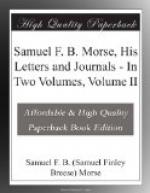“After the lecture I went home to tea with Newton, accompanied by Leslie, where I found our distinguished countryman, Washington Irving, our Secretary of Legation, and W.E. West, another American painter, whose portrait of Lord Byron gave him much celebrity. I passed a very pleasant evening, of course.
“The next day I visited the National Gallery of pictures, as yet but small, but containing some of the finest pictures in England. Among them is the celebrated ‘Raising of Lazarus’ by Sebastian del Piombo, for which a nobleman of this country offered to the late proprietor sixteen thousand pounds sterling, which sum was refused. I visited also Mr. Turner, the best landscape painter living, and was introduced to him....
“I did not see so much of London or its curiosities as I should have done at another season of the year. The greater part of the time was night— literally night; for, besides being the shortest days of the year (it not being light until eight o’clock and dark again at four), the smoke and fog have been most of the time so dense that darkness has for many days occupied the hours of daylight....
“On the 22d inst., Tuesday, I left London, after having obtained in due form my passports, for the Continent, in company with J. Town, Esq., and N. Jocelyn, Esq., American friends, intending to pass the night at Canterbury, thirty-six miles from London. The day was very unpleasant, very cold, and snowing most of the time. At Blackheath we saw the palace in which the late unfortunate queen of George IV resided. On the heath among the bushes is a low furze with which it is in part covered. There were encamped in their miserable blanket huts a gang of gypsies. No wigwams of the Oneidas ever looked so comfortless. On the road we overtook a gypsy girl with a child in her arms, both having the stamp of that singular race strongly marked upon their features; black hair and sparkling black eyes, with a nut-brown complexion and cheeks of russet red, and not without a shrewd intelligence in their expression.
“At about nine o’clock we arrived at the Guildhall Tavern in the celebrated and ancient city of Canterbury. Early in the morning, as soon as we had breakfasted, we visited the superb cathedral. This stupendous pile is one of the most distinguished Gothic structures in the world. It is not only interesting from its imposing style of architecture, but from its numerous historical associations. The first glimpse we caught of it was through and over a rich, decayed gateway to the enclosure of the cathedral grounds. After passing the gate the vast pile—with its three great towers and innumerable turrets, and pinnacles, and buttresses, and arches, and painted windows—rose in majesty before us. The grand centre tower, covered with a grey moss, seemed like an immense mass of the Palisades, struck out with all its regular irregularity, and placed above the surrounding masses of the same grey rocks. The bell of the great tower was tolling for morning service, and yet so distant, from its height, that it was scarcely heard upon the pavement below.




